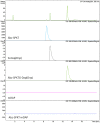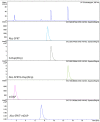Structure and function of a Clostridium difficile sortase enzyme
- PMID: 25801974
- PMCID: PMC4371152
- DOI: 10.1038/srep09449
Structure and function of a Clostridium difficile sortase enzyme
Abstract
Sortase enzymes are responsible for covalent anchoring of specific proteins to the peptidoglycan of the cell wall of gram-positive bacteria. In some gram-positive bacteria (e.g. Staphylococcus aureus), sortases have been found to be essential for pathogenesis and their inhibitors are under development as potential novel therapeutics. Here we provide the first report on the structural characterisation of the C. difficile sortase. An active site mutant was crystallised and its structure determined to 2.55 Å by X-ray diffraction to provide structural insight into its catalytic mechanism. In order to elucidate the role of the sortase in the cell wall biogenesis, a C. difficile sortase knockout strain was constructed by intron mutagenesis. Characterisation of this mutant led to the discovery that the putative adhesin CD0386 is anchored to the peptidoglycan of C. difficile by the sortase SrtB and that an SPKTG peptide motif is involved in the transpeptidation reaction with the C. difficile peptidoglycan. In an animal model for C. difficile infection, the SrtB mutant caused disease at a similar rate of onset as the wild type strain. In conclusion, our detailed study shows that the SrtB enzyme from C. difficile does not play an essential role in pathogenesis.
Figures






Similar articles
-
Functional analysis of Clostridium difficile sortase B reveals key residues for catalytic activity and substrate specificity.J Biol Chem. 2020 Mar 13;295(11):3734-3745. doi: 10.1074/jbc.RA119.011322. Epub 2020 Jan 31. J Biol Chem. 2020. PMID: 32005667 Free PMC article.
-
Structural Insights into Substrate Recognition by Clostridium difficile Sortase.Front Cell Infect Microbiol. 2016 Nov 22;6:160. doi: 10.3389/fcimb.2016.00160. eCollection 2016. Front Cell Infect Microbiol. 2016. PMID: 27921010 Free PMC article.
-
Disparate subcellular location of putative sortase substrates in Clostridium difficile.Sci Rep. 2017 Aug 23;7(1):9204. doi: 10.1038/s41598-017-08322-1. Sci Rep. 2017. PMID: 28835650 Free PMC article.
-
Sortase Transpeptidases: Structural Biology and Catalytic Mechanism.Adv Protein Chem Struct Biol. 2017;109:223-264. doi: 10.1016/bs.apcsb.2017.04.008. Epub 2017 Jun 5. Adv Protein Chem Struct Biol. 2017. PMID: 28683919 Free PMC article. Review.
-
Making and breaking peptide bonds: protein engineering using sortase.Angew Chem Int Ed Engl. 2011 May 23;50(22):5024-32. doi: 10.1002/anie.201008267. Epub 2011 Apr 27. Angew Chem Int Ed Engl. 2011. PMID: 21538739 Review.
Cited by
-
Characteristics of the Clostridium difficile cell envelope and its importance in therapeutics.Microb Biotechnol. 2017 Jan;10(1):76-90. doi: 10.1111/1751-7915.12372. Epub 2016 Jun 17. Microb Biotechnol. 2017. PMID: 27311697 Free PMC article. Review.
-
Substrate recognition in Bacillus anthracis sortase B beyond its canonical pentapeptide binding motif and use in sortase-mediated ligation.J Biol Chem. 2025 Apr;301(4):108382. doi: 10.1016/j.jbc.2025.108382. Epub 2025 Mar 4. J Biol Chem. 2025. PMID: 40049417 Free PMC article.
-
Rising prevalence and drug resistance of Corynebacterium striatum in lower respiratory tract infections.Front Cell Infect Microbiol. 2025 Jan 7;14:1526312. doi: 10.3389/fcimb.2024.1526312. eCollection 2024. Front Cell Infect Microbiol. 2025. PMID: 39839260 Free PMC article. Review.
-
Pilus biogenesis of Gram-positive bacteria: Roles of sortases and implications for assembly.Protein Sci. 2017 Aug;26(8):1458-1473. doi: 10.1002/pro.3191. Epub 2017 May 15. Protein Sci. 2017. PMID: 28493331 Free PMC article. Review.
-
Functional analysis of Clostridium difficile sortase B reveals key residues for catalytic activity and substrate specificity.J Biol Chem. 2020 Mar 13;295(11):3734-3745. doi: 10.1074/jbc.RA119.011322. Epub 2020 Jan 31. J Biol Chem. 2020. PMID: 32005667 Free PMC article.
References
-
- Starr J. M., Martin H., McCoubrey J., Gibson G. & Poxton I. R. Risk factors for Clostridium difficile colonisation and toxin production. Age Ageing 32, 657–660 (2003). - PubMed
-
- Just I. et al. The enterotoxin from Clostridium difficile (ToxA) monoglucosylates the Rho proteins. J Biol Chem 270, 13932–13936 (1995). - PubMed
Publication types
MeSH terms
Substances
Associated data
- Actions
Grants and funding
LinkOut - more resources
Full Text Sources
Other Literature Sources
Medical
Molecular Biology Databases

